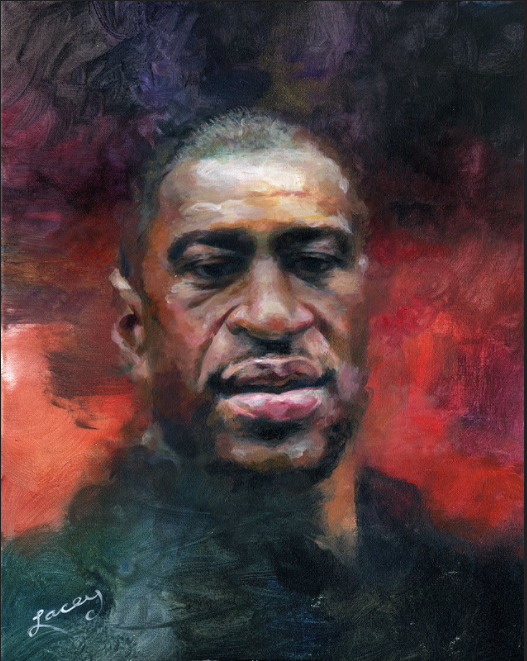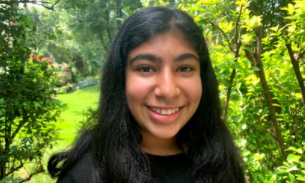Chauvin trial predicts course of police brutality
“George Floyd Portrait” by Dan Lacey is licensed under CC BY-NC 2.0.
Many remember George Floyd’s life and death during the Chauvin trial.
June 15, 2021
George Floyd’s murder added to a long history of race-based police brutality along with the deaths of Eric Garner, Michael Brown, Tamir Rice, Ahmaud Aubery, Breonna Taylor and countless other Black Americans, fueling public frustration and nationwide protests against the corruption of the criminal justice system.
Following a three-week trial and 10 hours of deliberation, the jury found Chauvin guilty on all three charges: second-degree unintentional murder, third-degree murder and second-degree manslaughter.
“I thought that justice was served and that was the conclusion the jury should have come to,” Black Student Association sponsor Raffinee Ehivue said. “But at the same time, I wish that George Floyd was still here. I wish that the situation never escalated to George Floyd being suffocated and that [Derek Chauvin] listened to the bystanders pleading with him to stop.”
Over a period of 10 days, the prosecution built a case that sought to prove that Floyd’s death was primarily tied to Chauvin’s use of unjustified force. On the other hand, the defense’s case was relatively brief, lasting only two days. Chauvin’s attorneys adopted a strategy of highlighting Floyd’s underlying medical conditions as reason for his death, thus undermining the link between Chauvin’s use of force and Floyd’s death.
According to the New York Times, Dr. David Fowler, Maryland’s former chief medical examiner, asserted that the position Floyd was kept in for over 9 minutes was safe, claiming that “all of [Floyd’s] injuries were in areas where the knee was not present.” He stated that a variety of medical conditions contributed to Floyd’s death, citing his enlarged heart and drug use. He also stated that carbon monoxide from the car exhaust affected Floyd’s blood.
In response, the prosecution called critical care physician and pulmonologist Dr. Martin Tobin to the stand, who rebutted Fowler’s arguments using tests that showed the level of carbon monoxide in Floyd’s blood was less than 2%—not enough to cause heart failure.
“The prosecution’s redirect of that witness after the defense’s cross-examination was brilliant,” social studies teacher Keenan Goldsby said. “It was succinct, to the point and shot down any holes the defense tried to point out.”
Although approximately 1,000 fatal police shootings are reported each year in the U.S., the annual arrest rate for police officers involved in violent crimes is approximately 1%, according to Vox. This arrest rate does not account for conviction. Since 2005, only 44 were convicted out of the 139 police officers arrested for on-duty manslaughter or murder: 37 for manslaughter or lesser charges and only 7 for murder. Implicit social factors may play a large role in this.
One example is the Blue Wall of Silence, an unofficial code among police officers to protect each other from being convicted of violent crime by withholding information, choosing not to report officer wrongdoing or refusing to testify in a trial concerning one of their colleagues. The Chauvin trial may indicate the crumbling of the Blue Wall of Silence.
“As people, we have always thought of the police as the highest degree of social purity,” Ehivue said. “In our eyes, they can do no wrong and must have unbelievable standards [of morality] because they enforce the laws. People have been slow to realize that the police are not perfect.”
In the trial, the four police officers that worked with Chauvin testified against him, including Minneapolis police chief Medaria Arradondo, Lt. Richard Zimmerman, Sgt. David Pleoger and Inspector Katie Blackwell. According to NBC News, the reasons for their testimonies in Chauvin’s trial may have included an attempt to reestablish public trust in the police and acknowledgement of the struggles Black people experience at the hands of law enforcement.
“I definitely think [the police officer testimonies] were a step towards accountability in the police force, simply because it usually never happens, especially for a white male officer [accused of a crime],” junior Aaliyah Wilkes said. “The task force acknowledging that what he did was wrong and speaking on it had a great impact [on the trial outcome].”
According to NPR, the use of video evidence specifically in cases of police brutality can hold officers more accountable for their wrongdoings. The use of body cameras as evidence was crucial to the trial outcome, with witnesses explaining the footage in their testimonies.
“Video evidence eliminates the ability of the police to manipulate what happened at the scene,” Ehivue said. “It allows the truth to come out. It’s not just ‘he said vs she said.’ Now, there is a movement to record the police. A lot of what people are doing when they are stopped by the police, especially Black males, is turning on their cameras.”
After the verdict, Chauvin’s lawyer appealed the case on several grounds, including the televising of the trial, witness intimidation, jury misconduct and whether jurors felt race-based pressure during the trial. One of the jurors was also found to be wearing a Black Lives Matter shirt at an MLK rally, raising questions about impartiality.
“It is going to be hard for an appeal to be successful in this case,” Goldsby said. “There was just so much evidence against Chauvin that I think the arguments raised by the defense will not be successful. However, in cases where the evidence is not so damning, these types of arguments might be able to gain some more traction.”
Although the Chauvin trial and verdict were distinct from previous cases of police brutality, many believe there is still a long way to go on the road to equality.
“I think slowly but surely, progress is being made,” Wilkins said. “But there are still so many things we need to keep fighting for to end systemic racism.”



